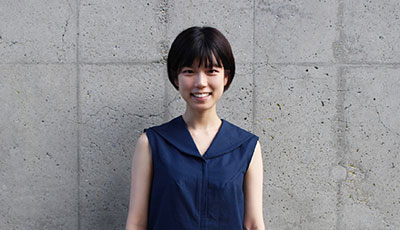
The function of tools is to “expand” our world.
| Department of Modern Mechanical Engineering (CSE Graduate School) Master’s program 2nd year |
| Natsuko Ichikawa |
| Takashi Uesugi Laboratory |

Q Can you describe your research in general terms?
I am working on developing a “quasi-paralysis inducing device” that makes it possible to experience symptoms similar to those of paralysis as experienced by stroke patients. Physical paralysis is a common consequence of stroke. The cause is to be found in the discrepancy between the patient’s movements and the brain’s perception of them. My “quasi-paralysis inducing device” allows you to experience this discrepancy by means of whole-body vibratory stimulation.
The quasi-paralysis inducing device is used by attaching it to the subject’s arms or legs. By applying vibratory stimulation to the tendons in the body, it creates ‘illusory reflexes’ in the subject. The feeling in these cases is similar to that of paralysis experienced by stroke patients.
In Japan’s aging society, stroke patients are a very familiar reality. Paralysis negatively affects every aspect of their lives. However, since caregivers have never experienced paralysis they cannot imagine what it implies concretely. This makes it difficult to provide appropriate care from the patient’s perspective. I believe that the “quasi-paralysis inducing device” will be useful in improving the quality of rehabilitation and assistance.
Q What did you keep in mind when designing the device?
My goal was to make it easy to use for everyone, from those with clinical experience to patients’ families. As a result, it’s a compact devise that can be easily assembled and used by people on their own.
By incorporating in its design the feedback received from physical therapists regarding its usability, we’ve been able to more closely mimic the effects of paralysis caused by a stroke.
Tools must sometimes take us out of our comfort zone
Q What did you learn at the Uesugi Laboratory?
Professor Uesugi’s idea is that “tools must sometimes take us out of our comfort zone.” Simply seeking automation and increased efficiency will end up limiting what we can achieve.
It is common to think that what you need for paralysis is just medical treatment. However, the thinking behind the quasi-paralysis inducing device is different. I think that learning about the difficulties patients face in their daily lives may actually be useful in caring for them.
This approach of “expanding our world through tools” is unique to the Uesugi Lab. If you are even slightly interested in this approach, I urge you to go to the Department of Modernl Mechanical Engineering and knock on the Uesugi Laboratory’s door.

